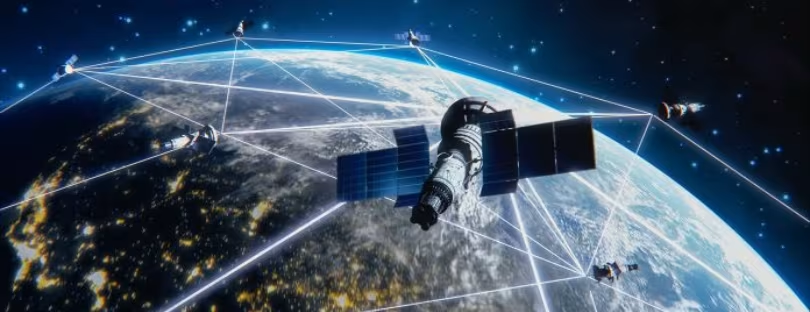
Global Satellite Revenue for 2022 Expected to Reach US$295 Billion, with Industry Leader SpaceX Collaborating with Taiwanese Telecom Companies for First Time Ever
In the global satellite market, LEO (low earth orbit) satellites currently hold the most significant advantage in terms of developmental potential due to their closer proximity with earth and their relatively lower latency, radiation, and cost compared to HEO (high earth orbit) and MEO (medium earth orbit) satellites, according to TrendForce‘s latest investigations.
Furthermore, not only do LEO satellites not require base stations, but they can also receive signals in difficult-to-reach and rural areas. As their signal coverage is not constrained by such geographical features as mountainous regions, oceans, and deserts, LEO satellites can synergize with 5G mobile communications by reaching areas that lack 5G coverage. After SpaceX generated much attention for LEO satellites, an increasing number of satellite operators have, in succession, applied to launch their own satellites. TrendForce expects annual satellite revenue for 2022 to reach US$295 billion, a 3.3% YoY increase.
With Europe, the US, China, Japan, and Korea participating in LEO satellite and 5G development, challenges still remain with respect to costs and long-term prospects
Regarding the deployment of LEO satellites by country, Asian countries, including China, differ from other major countries in terms of primary applications. Whereas non-Asian countries generally adopt LEO satellites for commercial purposes, Asian countries primary gear their deployment toward “national security” purposes. Some of the major developments in national security applications include AviChina’s Hong Yun project and CASC’s Hongyan constellation, both of which are expected to complete periodic missions in 2022. While policies relevant to the Chinese satellite industry are set by the Ministry of Industry and Information Technology, the industry itself is regulated by the Radio Association of China. In Japan, NTT DoCoMo oversees the development of 6G communication, with an emphasis on NTN technology, which works in tandem with LEO satellites. Finally, Korea’s MSIT recently unveiled its “6G R&D implementation plan”, which includes the launch of 14 LEO satellites by 2031.
Between LEO satellites and 5G telecommunications, the European and US markets are prioritizing ground-based 5G telecommunications first and finalizing the release of all frequency ranges in the 5G spectrum. While the number of ground stations and residents located in regions with 24.75-25.25GHz frequency bands are limited, LEO satellites shoulder the responsibility of preventing signal disruption. On the other hand, certain European organizations, such as the ESA and the European Commission, have established the SaT5G (Satellite and Terrestrial Network for 5G) consortium in order to drive forward the application of and integration between satellite and 5G communications.
In the industry’s current infancy, major satellite operators have launched more than a thousand small LEO satellites. In consideration of these satellites’ less-than-five years’ lifespans, operators will most likely focus on low-cost manufacturing and launching solutions in order to minimize CAPEX, in turn accelerating the pace of satellite adoption and lowering the overall cost of satellites. More specifically, not only have SpaceX and Amazon respectively engaged in vertical integration and streamlined their corporate structures, but they are also aligned with the demands of clients ranging from enterprises, governments, and consumers. As a result of these efforts, SpaceX and Amazon have effectively lowered the costs involved with collaborating with other suppliers.
Satellite recycling and space materials are two major sources of revenue auxiliary to the LEO satellite industry global satellite market
The 3GPP recently announced that it will finalize Release 17, which for the first time will include NTN (non-terrestrial networks), in 2022. Prior to this, mobile communications and satellite communications had been two separate, independently developing industries. That is why companies working across the two industries in the upstream, midstream, and downstream supply were generally different as well.
After 3GPP includes NTN in its upcoming release, the two industries are likely to generate more opportunities for collaboration. At the moment, Tesla subsidiary SpaceX has applied to launch the most satellites among all satellite operators, which include Amazon, Britain-based OneWeb, and Canada-based Telesat, among others. Notably, US operators have launched more than 1,000 satellites, which represent more than 50% of the global total.
Signal transmission and reception between satellites and ground stations are relatively limited. As such, four major satellite technologies, including collision prevention, management, communications, and ground base-satellite transmission, represent four major areas in which potential suppliers can participate. However, given the intense competition among satellite operators, once LEO satellite deployment reaches a global scale in the future, issues such as light pollution may begin to adversely affect planetary and other astronomy research. TrendForce therefore believes that companies capable of supplying materials that can lower satellite reflectivity are likely to experience considerable growth going forward. In addition, small LEO satellites’ lifespan of less than five years will also result in space debris issues. Hence, effectively recycling satellites back to earth is yet another potential commercial opportunity in the space industry.
Starlink is partnering with Taiwanese telecom companies for the first time and is expected to expand these companies’ services areas starting from ground stations global satellite market
At the moment, one of the pain points associated with LEO satellites is the difficulty for ground stations’ antennas to track satellite signals. Hence, Taiwanese companies that primarily specialize in base station building are therefore likely to benefit from potential partnerships with LEO satellite operators. Although satellite-related companies in Taiwan traditionally focused on manufacturing equipment and components for MEO and HEO satellites, the rise of the LEO market has now persuaded these companies (including MTI, WNC, Kinpo, UMT, Tong Hsing, GPI, WIN, Chicony, EMC, Compeq, and Shenmao) to become suppliers for SpaceX’s Starlink satellite internet system.
Having taken notice of Taiwan’s strategic position that connects northern Asia with Southeast Asia, US-based SpaceX has reached out to Taiwan’s National Communications Commission (NCC) and Chunghwa Telecom, with the latter subsequently confirming its partnership with SpaceX. Chunghwa Telecom is now looking to extend this partnership to a comprehensive business relationship that goes beyond base stations. As the Starlink internet service is expected to be available in Taiwan next year, Chunghwa Telecom will become the sole distributor of Starlink in Taiwan. Now that SpaceX has launched more than 1,800 satellites, Chunghwa Telecom will likely facilitate increased internet connection speed for Starlink via its 18,000 base stations located throughout Taiwan, which synergize with the satellites for better, more comprehensive coverage. global satellite market









